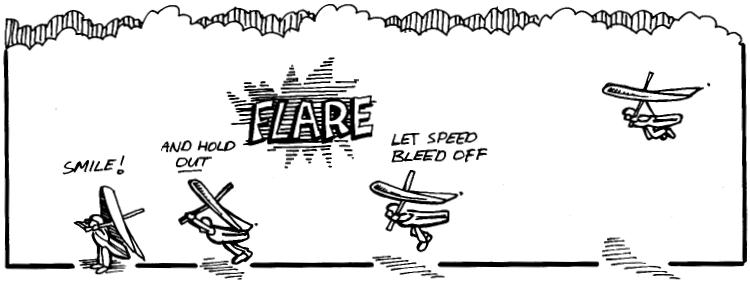Nil or Light Wind
Landing
These landings involve very precise
timing of the flare. Ground speed will be high so any misjudgment can involve
hitting the ground or the glider very hard. Be prepared for considerable float
in 'ground effect'. From the 'ideal position' you
should:
INCREASE
SPEED
Max. glide speed provides good
control response. Move hands to uprights (just below 1/2 way up them). Get legs
clear of harness but keep them back and shoulders down. Look ahead. Maintain
speed
HOLD
OFF
Round out so base bar 3 feet above
ground. Maintain 3 feet by small 1/2" pushouts, slowly bleeding off
speed.
FLARE
When no
longer possible to maintain 3', flare out and up in one swift full movement.
Land on legs.
FINISH
Unclip. Move
glider out of landing area. Park securely
Common Faults:
Slowing the glider down on approach results in no energy for flare.
Moving body into upright position - results in reduced amount of flare
available. (Important in nil wind). Flaring too early - glider climbs, pilot
pulls back, glider noses in. Unless you have climbed fifteen feet or more NEVER
PULL
BACK.
Flaring too gently - here the glider climbs and stalls, the nose drops through
(as with most stalls) and you stuff in.
Flaring too late - here the glider
simply mushes forward, nose stalling and dropping, tips still flying, the pilot
hanging out the back wishing he was elsewhere.
Trying to run the glider on. The
transfer of the pilot's weight to the ground effectively removes the control
pivot point (the top of the hang strap). Any push out simply pushes the glider
forward rather than rotating it nose up.
Not looking ahead - height judgment
depends on peripheral vision. The correct flare rotates the nose up near the vertical,
killing all lift and killing all forward energy - the wing becoming effectively
a huge drag brake. The centre of gravity of the wing is placed above or slightly
behind the pilot's C of G so the wing falls back vertically onto the pilot's shoulders.
If the landing really does turn to worms, and you are about to nose in in
a big way, let go of the uprights in the last split second. You might save the
upright, and much more importantly you might save your arm.
If nil-wind landings are giving you trouble why not put some wheels on your glider
and go back to the training slope or to the winch field next time there's light
winds, and spend an afternoon practicing? If you can, get your Club Coach or an
Instructor to watch you to see if he can identify the problem area - once that's
identified doing something about it becomes easier. Good luck and (dare I say
it) Happy Landings, Pie by
Graeme Baird
